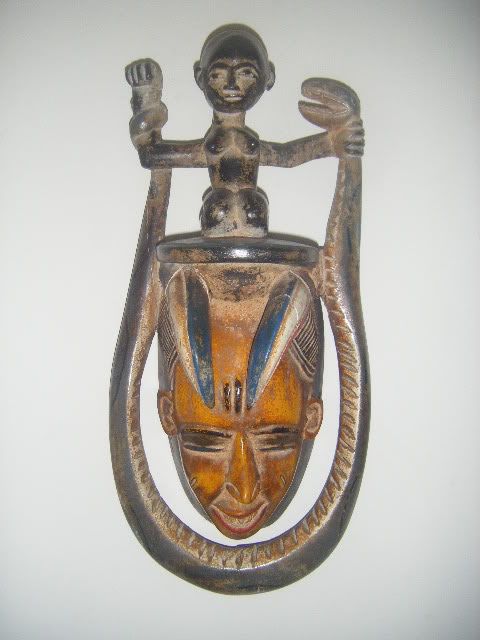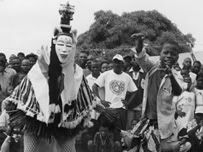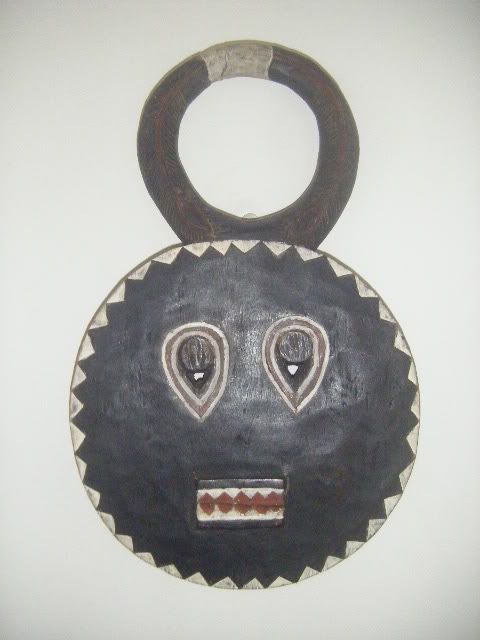Today I made some further researches in relation to African quotes and here are some new African quotes from West Africa.
Don’t insult the crocodile until you cross the water.
It means be careful when you critize others
Only a knife knows what the inside of a coco-yam looks like.
It means that the person who investigate and research something understand the subject.
A big blanket encourages sleeping in the morning.
It means that luxury encourages idleness. If you have worked hard and made wise choices, you will
find contentment.
A bird that is eating guinea-corn keeps quiet.
It means that you should dedicate yourself to a task.
Rats don’t dance in the cat’s doorway.
It means that you should not look for trouble.
A hippopotamus can be made invisible in dark water.
It means that it is important to be informed and alert. Ignorance can lead to danger.
If your house is burning, there is not time to go hunting.
It means that it is important to make priorities.
Don’t forget that you can purchase African art if you visit the following links below:
http://ie.four.ebid.net/stores/myafrikart
http://myworld.ebay.ie/whatagwanagal/
Sunday, November 30, 2008
Sunday, November 23, 2008
African art: Zaouly ( Zaouli) mask
Zaouly mask is a symbol of the Gouro community in Ivory Coast.
It is said that Djela Lou Zaouly was a goddess for the Gouro people. The Gouro word “ Djela Lou Zaouly” means “ The lion’s daughter”.Zaouly is a goddess for beauty.
You can purchase a Zaouly mask if you visit one of the following links:
http://ie.four.ebid.net/stores/myafrikart
http://myworld.ebay.ie/whatagwanagal/
Zaouly masks have always bright colours . They can be used for ceremonies and also in funerals. They are always associated with a special stylish dance . You can see the dance if you visit the following links:
http://www.youtube.com/watch?v=Ve_O9L4RS0I
http://www.youtube.com/watch?v=3M5GVwXb2XY
Saturday, November 22, 2008
Ebay versus Ebid
A quick note to inform you that My Afrik’Art is currently testing a new auction platform called Ebid.
You can see our listing if you visit the following link:
http://ie.four.ebid.net/stores/myafrikart
The main advantage of Ebid is the fact that the insertion fees are minimum or even inexistant compare to Ebay. Therefore you don’t have to pay if your item does not sell. It seems fair compare to Ebay which is charging you a lot of money and does not help you bring more traffic to your auction ( for instance changing the way their search engine works does not help a lot of sellers). Ebay became too big and they forgot to stay human. Ebay customer service is very bad and most of the time when you contact them for an issue, they don’t even bother to answer you.
Therefore I invite everybody who is currently Ebay addict or fan to have a look at ebid and see by yourself.
Happy bidding…
Wednesday, November 19, 2008
African mask - Kple Kple mask
Let’s look at one type of mask that we never referred to before: Kple Kple mask
The Kple Kple mask is from the Baoule community in Ivory Coast.
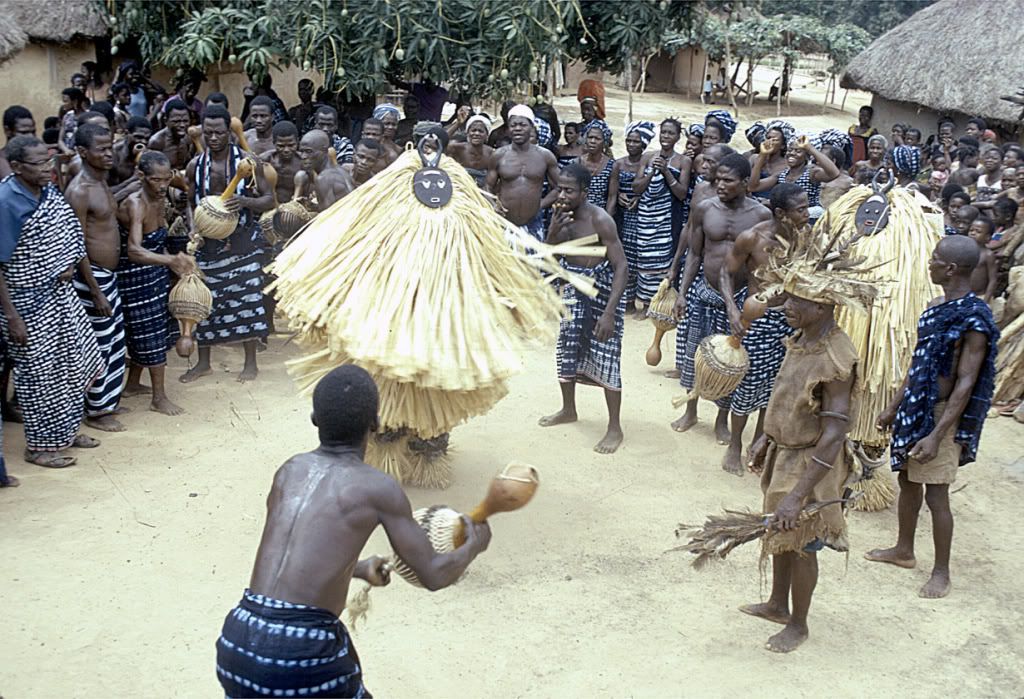
Baule masked dancers of the Goli society, Kondeyaokro village, Côte d’Ivoire. Photograph by Eliot Elisofon, 1972
You can purchase this type of mask if you visit the following link before the 2nd of December. It could be a nice present to add an exotic touch in some of your relatives house or even if your house during the winter time:
http://myworld.ebay.ie/whatagwanagal/
The Kple Kple mask is from the Baoule community in Ivory Coast.
The face refers to the sun, and the sunbeams are represented by polychromed triangles.This type of mask is usually used in commemorative, agricultural and burial ceremonies. The mask would generally be worn with a raffia (grass) costume attached to the lower section of the mask reaching to below the waist with a grass skirt and other grasses covering the body and legs.
Below you will see an image of a ceremony when the Kple Kple mask was used.

Baule masked dancers of the Goli society, Kondeyaokro village, Côte d’Ivoire. Photograph by Eliot Elisofon, 1972
You can purchase this type of mask if you visit the following link before the 2nd of December. It could be a nice present to add an exotic touch in some of your relatives house or even if your house during the winter time:
http://myworld.ebay.ie/whatagwanagal/
Sunday, July 27, 2008
African art ( part 2): African art and craft seen with new eyes
More and more people such as art galleries, collectors and even tourists visiting Africa tend to sell African art. However all these people tend to only look at African art with an aesthetic judgement and they forgot that the objects were not created for this purpose. Their creators wanted to create sacred objects useful for their communities. So the question is how can you sell and inform about African art and craft without omitting the main goal of the African artists?
It is important to know that African art went through different status over the last centuries. Of course, all the different status were always set by the Westerner people:
-XVth-XVIIIth century: African art = curiosity
While the Portuguese are the first to arrive in Black Africa , they try to impose the christianity to African people and they burn any wood art created by the inhabitants for their rituals. However Portuguese have a growing interest for ivory and gold. So to sum up during this period, all the ritual and sacred objects are encountering a negative judgment from the Portuguese and the other objects ( objects made of ivory for instance) are judged using Westerner criteria and they are brought back to Europe to be shown in what is called “ curiosity” chambers. These special chambers were successful until the XVIIIth century. The main goals of these chambers are to entertain, fascinate and teach.
-XIXth century: From curiosity to scientific objects
At the end of the XIXth century, the westerner expeditions changed and scientists are now part of them. Slowly the “curiosity chambers” became museums. The objects placed in museums are now used for ethnographic specimen and they are the witnesses of civilization progress. During this period, the objects are only studies by ethnologists and never by art historians. In the last 25 years of the XIXth century, colonialism is fully part of the Westerner strategies and universal exhibitions show African objects and also humans. African people are brought back to Europe to be put in museums so that westerner people can see how it is to live in Africa.
-XXth century : From scientific objects to primitive arts
Primitive arts appeared since the middle of the XIXth century but at this period, the expression “ primitive arts” means that it was created by people in the first period of evolution. A lot of Westerner artists had an interest for African objects but they only look at them from an aesthetic point of view.
-Today : An art fully recognized but still not fully understood by a lot of persons
Since 1960, primitive art has a growing public. For instance the Branly museum opened in 2005.
You can discover African art by visiting the following website: http://www.myafrikart.com
It is important to know that African art went through different status over the last centuries. Of course, all the different status were always set by the Westerner people:
-XVth-XVIIIth century: African art = curiosity
While the Portuguese are the first to arrive in Black Africa , they try to impose the christianity to African people and they burn any wood art created by the inhabitants for their rituals. However Portuguese have a growing interest for ivory and gold. So to sum up during this period, all the ritual and sacred objects are encountering a negative judgment from the Portuguese and the other objects ( objects made of ivory for instance) are judged using Westerner criteria and they are brought back to Europe to be shown in what is called “ curiosity” chambers. These special chambers were successful until the XVIIIth century. The main goals of these chambers are to entertain, fascinate and teach.
-XIXth century: From curiosity to scientific objects
At the end of the XIXth century, the westerner expeditions changed and scientists are now part of them. Slowly the “curiosity chambers” became museums. The objects placed in museums are now used for ethnographic specimen and they are the witnesses of civilization progress. During this period, the objects are only studies by ethnologists and never by art historians. In the last 25 years of the XIXth century, colonialism is fully part of the Westerner strategies and universal exhibitions show African objects and also humans. African people are brought back to Europe to be put in museums so that westerner people can see how it is to live in Africa.
-XXth century : From scientific objects to primitive arts
Primitive arts appeared since the middle of the XIXth century but at this period, the expression “ primitive arts” means that it was created by people in the first period of evolution. A lot of Westerner artists had an interest for African objects but they only look at them from an aesthetic point of view.
-Today : An art fully recognized but still not fully understood by a lot of persons
Since 1960, primitive art has a growing public. For instance the Branly museum opened in 2005.
You can discover African art by visiting the following website: http://www.myafrikart.com
Thursday, July 10, 2008
The Baoulé tribe
As mentioned previously, the Baoulé tribe is part of the bigger ethnic group called the Akan. The Baoulé live mainly in the middle of Cote d’Ivoire. The Baoulé population is estimated to be around 3 millions.
The Baoulé originally come from Ghana and they were lead to Cote d’Ivoire by Queen Abla Pokou. I wrote an earlier note in relation to Queen Abla Pokou. Their name come from the legend in relation to the Queen Abla Pokou and “baouli” means “ the child is dead”.
One of the former president of Cote d’Ivoire named Houphouët-Boigny was part of the Baoulé tribe.
The Baoulé as a lot of ethnic tribes in Ivory Coast have their own dance:
-Goly dance
- Adjemele dance
-Adjos dance
- Kotou dance
The Baoulé are famous sculptors, weaver and goldsmith.
The Baoulé believe in a creator God. Their God controls men and animals. Spirits have supernatural powers. The real world is the opposite of the spiritual world where souls come from at birth and go back at death. Their belief is founded around the death and the immortality of the soul. The Baoule do ancestors workship but ancestors are not represented.
In the Baoule culture, sculptures and masks allows them to be in contact with the spiritual world. Baoule traditional masks are always wore by the men. Traditional masks corresponds to 3 types of dances/events
- Gba gba: originally from the Guro tribe, this mask is used for women funerals during the harvest seasons. It celebrates beauty.
- Bonu amuen: it protects the village from outside threats. It appears during the death of notable people.
- Goli: this mask has a rounded form and two horns. It celebrates peace and happiness.
In contrary to other ethnic groups, the sculptors skills are not passed over from father to son. It results from a personal choice.
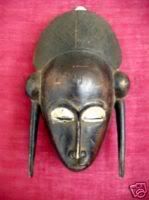
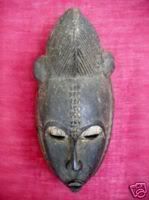
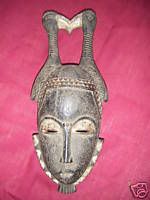
You can see more masks if you visit : http://www.myafrikart.com
The Baoulé originally come from Ghana and they were lead to Cote d’Ivoire by Queen Abla Pokou. I wrote an earlier note in relation to Queen Abla Pokou. Their name come from the legend in relation to the Queen Abla Pokou and “baouli” means “ the child is dead”.
One of the former president of Cote d’Ivoire named Houphouët-Boigny was part of the Baoulé tribe.
The Baoulé as a lot of ethnic tribes in Ivory Coast have their own dance:
-Goly dance
- Adjemele dance
-Adjos dance
- Kotou dance
The Baoulé are famous sculptors, weaver and goldsmith.
The Baoulé believe in a creator God. Their God controls men and animals. Spirits have supernatural powers. The real world is the opposite of the spiritual world where souls come from at birth and go back at death. Their belief is founded around the death and the immortality of the soul. The Baoule do ancestors workship but ancestors are not represented.
In the Baoule culture, sculptures and masks allows them to be in contact with the spiritual world. Baoule traditional masks are always wore by the men. Traditional masks corresponds to 3 types of dances/events
- Gba gba: originally from the Guro tribe, this mask is used for women funerals during the harvest seasons. It celebrates beauty.
- Bonu amuen: it protects the village from outside threats. It appears during the death of notable people.
- Goli: this mask has a rounded form and two horns. It celebrates peace and happiness.
In contrary to other ethnic groups, the sculptors skills are not passed over from father to son. It results from a personal choice.



You can see more masks if you visit : http://www.myafrikart.com
Sunday, June 29, 2008
Senufo group and the secret society: Poro
The Senufo live in Mali, Ivory Coast, Burkina Faso, and Ghana. “Senufo” means “ the ones who speak Sene” . Senufo people were in the past farmers cultivating rice, corn,yams,etc.Their population is estimated to be around 600 000.
The Senoufo have a very interesting political system. It is a matrilineage society. They are four societies which educate and governs the Senufo: Poro, Sandogo, Wambele and Tyepka.We will mainly speak about the Poro society today.
The Poro society is reserved for men ( but it is good to know that apparently young girls and postmenopausal women are permitted to join) and it is a secret society. The main purpose of the Poro society is to guarantee a good relationship between the living world and the ancestors. They are responsible for the religious traditions, ceremonies and also for maintaining the order between the people.
When men are part of the Poro society, they have to go through 3 different phases of 7 years each. It generally starts when the boy are 7 years old and end when they are 28 years old. During the induction, the young men converse with each other using a secret language known only to other Poro members .
It is important to know that in the Senufo culture, when a man is born, it is only an animal and the Poro will help them to change their status.
The different phases can be broken down to:
- The “Kouord”: children are given special tasks and also learn special symbolic words.
- The “dain”: it teaches teenagers how to live in community .During this period, the teenagers are asked to make personal sacrifices. They are taught how to participate in rituals, how to prepare the ritual clothes,etc.
- The “Tcholo”: it helps in understanding the meaning of life. The elders will reveal some secrets that young men were not able to understand until this period. Young men will be taught about philosophy, social behaviours and a professional skill.
- The “Kaffono”: this gives the supreme knowledge and the final sacrament.
Once initiate, the men need to give an annual contribution. In exchange, they will receive support from the elders, they are also protected by the masters and after their death, their funerals are organized by the Poro members.
All the initiatory ceremonies are happening in a sacred wood outside of the villages. This place is considered as the propriety of Katyéléo ( The Senufo goddess).
.The Senufo produce a rich variety of sculptures, mainly associated with the poro society. The sculptors and metalsmiths, endogamous groups responsible for making the cult objects live on their own in a separate part of the village.
You can find Senoufo statues and masks if you go to : http://www.myafrikart.com
The Senoufo have a very interesting political system. It is a matrilineage society. They are four societies which educate and governs the Senufo: Poro, Sandogo, Wambele and Tyepka.We will mainly speak about the Poro society today.
The Poro society is reserved for men ( but it is good to know that apparently young girls and postmenopausal women are permitted to join) and it is a secret society. The main purpose of the Poro society is to guarantee a good relationship between the living world and the ancestors. They are responsible for the religious traditions, ceremonies and also for maintaining the order between the people.
When men are part of the Poro society, they have to go through 3 different phases of 7 years each. It generally starts when the boy are 7 years old and end when they are 28 years old. During the induction, the young men converse with each other using a secret language known only to other Poro members .
It is important to know that in the Senufo culture, when a man is born, it is only an animal and the Poro will help them to change their status.
The different phases can be broken down to:
- The “Kouord”: children are given special tasks and also learn special symbolic words.
- The “dain”: it teaches teenagers how to live in community .During this period, the teenagers are asked to make personal sacrifices. They are taught how to participate in rituals, how to prepare the ritual clothes,etc.
- The “Tcholo”: it helps in understanding the meaning of life. The elders will reveal some secrets that young men were not able to understand until this period. Young men will be taught about philosophy, social behaviours and a professional skill.
- The “Kaffono”: this gives the supreme knowledge and the final sacrament.
Once initiate, the men need to give an annual contribution. In exchange, they will receive support from the elders, they are also protected by the masters and after their death, their funerals are organized by the Poro members.
All the initiatory ceremonies are happening in a sacred wood outside of the villages. This place is considered as the propriety of Katyéléo ( The Senufo goddess).
.The Senufo produce a rich variety of sculptures, mainly associated with the poro society. The sculptors and metalsmiths, endogamous groups responsible for making the cult objects live on their own in a separate part of the village.
You can find Senoufo statues and masks if you go to : http://www.myafrikart.com
Labels:
african art,
african culture,
african mask,
african tribes,
ebay,
poro,
senoufo,
senufo,
traditional african art
Subscribe to:
Comments (Atom)

